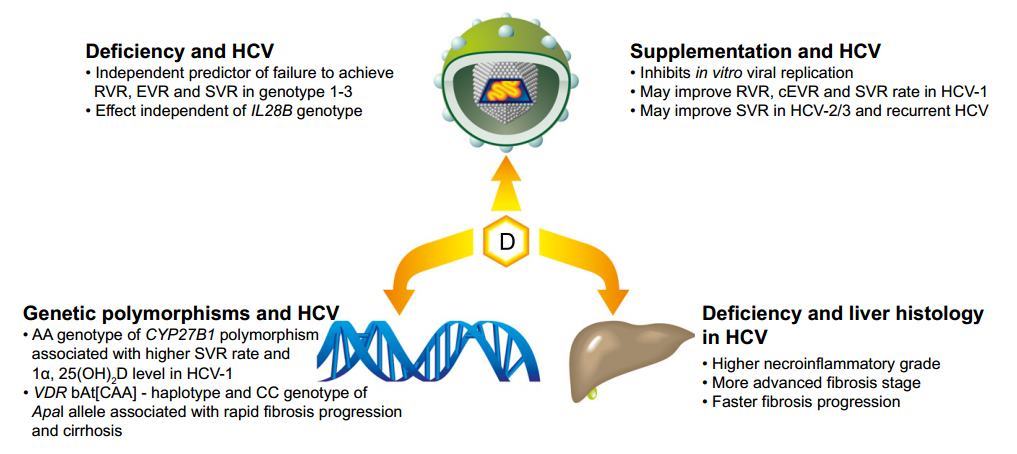Vitamin D Deficiency May Help Spread of Hepatitis B Throughout Liver
Press release: 06 June 2013 Wiley
Researchers from Germany have found that low levels of vitamin D are associated with high levels of hepatitis B virus (HBV) replication. Findings published online in Hepatology, a journal of the American Association for the Study of Liver Diseases, suggest seasonal fluctuations in vitamin D and HBV levels point to a link in these variables among patients with chronic HBV.
While highly effective vaccines are available, HBV still remains one of the most significant infectious diseases worldwide .
In fact, the World Health Organization (WHO) states that HBV is 50 to 100 times more infectious than human immunodeficiency virus (HIV) .
Furthermore WHO reports that two billion individuals have been infected with HBV, which is responsible for nearly 600,000 deaths each year .
In the U.S. the Centers for Disease Control and Prevention (CDC) estimates that up to 1.4 million Americans are living with chronic HBV.
“Vitamin D helps maintain a healthy immune system and there is evidence of its role in inflammatory and metabolic liver disease, including infection with hepatitis C virus (HCV),” explains lead investigator Dr. Christian Lange from Johann Wolfgang Goethe University Hospital in Frankfurt. “However, the relationship between vitamin D metabolism and chronic HBV infection remains unknown and is the focus of our present study.”
Between January 2009 and December 2010, the team recruited 203 patients with chronic HBV who had not previously received treatment for their infection. Levels of 25-hydroxyvitamin D were measured from each participant. Patients co-infected with HCV, HIV, or hepatitis D; those with excessive alcohol use; and those with liver cancer or other malignancies were excluded.
Results show that
34% of participants had severe vitamin D deficiency (less than 10 ng/mL),
47% with vitamin D insufficiency (between 10-20 ng/mL) and
19% had normal levels of vitamin D (greater than 20 ng/mL).
Further analyses indicate that the concentration of HBV in the blood, known as viral load, was a strong indicator of low vitamin D levels. In patients with HBV DNA less than 2000 IU/mL versus 2000 IU/mL or more, the levels of vitamin D were 17 and 11 ng/mL, respectively.
Researchers also determined that patients with the hepatitis B antigen (HBeAg) had lower levels of vitamin D than HBeAg negative participants. Inverse seasonal fluctuations between vitamin D and HBV levels were noted, which further suggests a relationship between the two variables.
“Our data confirm an association between low levels of vitamin D and high concentrations of HBV in the blood,” concludes Dr. Lange. “These findings differ from previous research of patients with chronic hepatitis C, which found no connection between vitamin D levels and concentration of HCV in the blood.” The authors propose further investigation of vitamin D as a therapeutic intervention for controlling HBV.
Abstract
Vitamin D is an important immune modulator which plays an emerging role in inflammatory and metabolic liver diseases, including infection with hepatitis C virus (HCV). In contrast, the relationship between vitamin D metabolism and chronic hepatitis B is less well characterized. Therefore, we quantified 25-hydroxyvitamin D [25(OH)D3 ] serum levels in a cohort of 203 treatment-naïve patients with chronic hepatitis B virus (HBV) infection and tested for their association with clinical parameters of chronic hepatitis B. 69 (34%), 95 (47%), and 39 (19%) out of 203 patients had severe vitamin D deficiency [25(OH)D3 <10ng/mL], vitamin D insufficiency [25(OH)D3 ≥10ng/mL and <20ng/mL], or adequate vitamin D serum levels [25(OH)D3 ≥20ng/mL], respectively. In both uni- and multivariate analyses, HBV DNA viral load (log10 IU/mL) was a strong predictor of low 25(OH)D3 serum levels (p=0.0007 and p=0.000048, respectively), and vice versa.
Mean 25(OH)D3 serum concentrations in patients with HBV DNA <2000 IU/mL vs. ≥2000 IU/mL were 17 vs. 11 ng/mL, respectively (p<0.00001).
In addition, hepatitis B early antigen (HBeAg) positive patients had lower 25(OH)D3 serum levels than HBeAg negative patients (p=0.0013). Finally, 25(OH)D3 and HBV DNA serum levels showed inverse seasonal fluctuations.
Conclusions: Low 25(OH)D3 serum levels are associated with high levels of HBV replication in patients with chronic hepatitis B. This represents a major difference to chronic hepatitis C, were numerous previous studies have shown a lacking correlation between HCV viral load vitamin D serum levels. Inverse seasonal fluctuations of 25(OH)D3 and HBV DNA serum levels are suggestive for a functional relationship between both variables. (HEPATOLOGY 2013.).
See also VitaminDWiki
Hepatitis B virus reduced by 5X the Vitamin D getting to liver cells in the lab – Oct 2018
Virus category listing has items along with related searches
Hepatitis B clinical event was 2X more likely if low vitamin D – Oct 2014
Hepatitis B virus might be treated by Vitamin D – April 2015
Vitamin D in chronic liver disease PDF, not web page
Vitamin D can inhibit enveloped virus (e.g. Corona, Herpes, Bird Flu, Epstein, Hepatitis, RSV, etc.) – March 2011 such as Hepatitis B virus
Important interactions between the liver and vitamin D – May 2013 which has the following
- Hepatitis - C

all items in Immunity and vitamin D items
Attached at bottom of this page: Hepatitis and Vitamin D Poster
Attached at bottom of this page: Another Hepatitis B study - 2013
Attached at bottom of this page:Theoretical basis of a beneficial role for vitamin D in viral hepatitis - 2012
25-Hydroxyvitamin D3 suppresses hepatitis C virus production – Oct 2012
Cholesterol and vitamin D book - 2009
- Which includes following charts from 2011 presentation by Dr. Grimes
- Horizontal axis = individual patient - sorted by vitamin D level: clearly low vitamin D associated with HBV

- Overview Liver and vitamin D a properly functioning level is essential for vitamin D to be processed
- You can take the form of vitamin D which is produced by the liver, thus eliminating the need for normal vitamin D
- The following is one of the many diagrams of Vitamin D in the body

